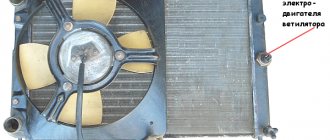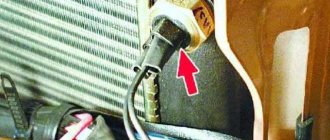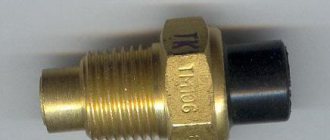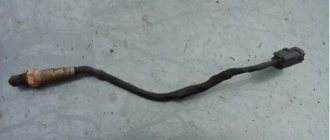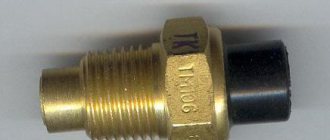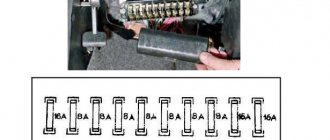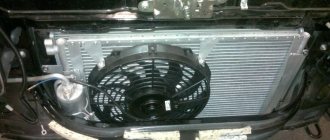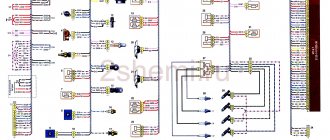To maintain the optimal temperature in the engine, a cooling system is installed in the car. One of the main elements in this system are fans, thanks to which the required amount of air is supplied to the engine through the radiator core. If it stops working, the Niva Chevrolet cooling fan overheats as excess heat begins to accumulate. Unlike classic cars, it has two fans, making the functioning of the systems much more complicated. If the arrow that shows the temperature is in the red area, and the cooling system refuses to work, and at the same time the cooling fan does not turn on, then the car should be taken to a car service center as quickly as possible, or you should try to find the cause of the malfunction yourself.
Causes of malfunction
The first thing you should pay attention to when the system is not working is the state of the fuses, which are located under the front panel, on the passenger side, in a special mounting block. A pair of fuses are responsible for the cooling operation; if the right one fails, then both fans stop working, and if the left fuse blows, then one element can continue to operate.
In addition, the mounting block has three relays that are responsible for operating the fans at different speeds. And if the relay responsible for operation at low speeds burns out, then the cooling system works correctly only at high speeds, and at low speeds the engine begins to heat up. Power is supplied to the relay through a special fuse, which can also fail, causing system failure.
Failure of temperature sensors also affects proper cooling operation. They are located on the engine. They operate when the desired temperature is reached, one when it reaches 90 degrees, and the second when it reaches 101 degrees. It is recommended to start checking with them, this is done this way: the connector is disconnected from the electric motor, and power is supplied to them directly through the battery; if the electric motor is running, then the reason is in the sensors.
If after checking everything, fuses, relays and sensor are in order, you should pay attention to the fans.
Chevrolet Niva cooling fan does not turn on
The Chevrolet Niva SUV, which is popular in our country, is equipped with a high-quality cooling system that allows you to constantly maintain optimal engine thermal conditions. A special role in this unit belongs to two fans, which provide the required air flow through the radiator core.
If the cooling fan on a Chevrolet Niva does not turn on, excess heat will no longer be removed from the engine, which will lead to overheating of the engine. Since the number of cooling fans on this car model has been increased, the electrical circuit of their operation has become much more complex than in classic passenger cars.
Why doesn't the cooling fan work?
If the cooling fan does not turn on on a Chevrolet Niva, the first thing you need to do is check the condition of the fuses responsible for the operation of the unit. The fuses are located in the mounting block under the front panel, near the front passenger's feet. This car has two fuses that protect the electrical circuit of the fan motor.
The mounting block contains three relays responsible for connecting the left fan at high speed and the right fan at low and high rotation speed. The additional relay is activated when a signal is applied from terminal number 46 of the ECM to terminal number 86. In this case, the voltage to the fan motor terminals passes through a resistor.
If this resistor burns out or the relay fails, the cooling fan on the Chevrolet Niva will stop turning on at low speed. The right fan relay is activated after a control signal is received from terminal number six to terminal number 86. This allows you to switch to high fan speed.
If there is no control signal, we can talk about a failed relay. At the same time, the cooling fan on the right side of the Chevrolet Niva does not turn on. It is important to remember that the same control signal is responsible for turning on the left fan. In this case, a jumper process occurs between terminals 85 and 86. However, the fan motor on the left is powered via a separate fuse.
The cooling fans on the Chevrolet Niva do not turn on even if the sensor that detects the coolant temperature breaks down. According to this sensor, the system understands how much the coolant temperature has increased or decreased. In this case, the controller determines whether to turn the fans on or off.
It happens that fans do not turn on due to deformation of the plastic casings of the parts. This can happen if the temperature in the engine compartment is too high. In this case, the fan blades will touch the casing, which will lead to overheating and melting of the tips. When the fans stop, the blades will simply weld to the casing and will not be able to work the next time they are turned on.
Read news about the new Niva
- Air conditioning Niva Chevrolet - design and repair
- FROST car air conditioners // Online store // Prices // Air conditioners for cars Lada VAZ, VolksWagen Polo, Daewoo Matiz
- Cooling system Niva Chevrolet: diagram, faults and their elimination | Niva Repair
- Pump for Chevrolet Niva - Auto workshop online
- Niva Chevrolet installation of air conditioning - Auto magazine MyDucato
- Niva Chevrolet installation of air conditioning - Auto magazine MyDucato
- Why the Chevrolet Niva air conditioner does not turn on: reasons and installation (diagram), belt replacement
- Niva Chevrolet installation of air conditioning - Auto magazine MyDucato
Checking and removing fans
To understand whether they work or not, you need to disconnect the connector from their motors, and connect a lamp to the wires through which voltage is supplied; we do the same with the sensor; if both lamps light up, then the problem is in the fans.
To remove them you need to do the following:
- Disconnect all wires
- Removing the upper pipe
- Removing the bumper
- If there is an air conditioner, bend the tubes (this must be done carefully, as they may burst) or drain the freon (filling it back will not be cheap), then remove the air conditioner radiator.
- You need to loosen the nuts on the radiator casing
- Tilt the radiator so that you can remove the fan unit
- Unscrew the bolts that secure the block and remove it
After removal, it is recommended to immediately replace both with new ones, since there is a possibility that a little time will pass and the second element will fail and all replacement work will need to be done again. You can do this procedure from below, but you will need special equipment, and you will need to move the engine ten centimeters back, which is very labor-intensive.
Fans of the Niva Chevrolet cooling system are used for forced ventilation of the radiator. They increase the intensity of heat dissipation while driving at low speeds and are the only way to cool the antifreeze in a plug or “toffee”.
Purpose and principle of operation
The car engine experiences significant heating during operation. Inside the cylinders, the gas temperature reaches 2000 degrees Celsius. The cooling system is designed to relieve such temperature stress. For this purpose, the engine contains a so-called water jacket - a system of channels through which coolant passes. Thanks to forced circulation, heat is removed outside.
Pipes, pump, thermostat - that's the whole cooling system. "Niva Chevrolet", the flow diagram of antifreeze or antifreeze of which is shown in the figure above, cools quite quickly. This is provided by a water pump, which in turn is driven by the crankshaft pulley through a serpentine belt. On a cold engine (coolant temperature up to 78°C), the thermostat is closed and circulation occurs in a “small circle”, bypassing the cooling radiator. In the “small circle”, in addition to the engine jacket, the heater radiator and the throttle heating unit are required.
After the engine, and therefore the antifreeze, warms up (over 80°C), the thermostat opens and coolant circulates through the main cooling radiator. The radiator contains two vertical plastic tanks and an aluminum central part of horizontal channels. Antifreeze enters through the upper pipe into the right tank and leaves the radiator through the outlet pipe from the left tank. The radiator drain plug is also located here.
Design and principle of operation
The designers of the Chevrolet Niva used a dual fan unit in the cooling system. This slightly complicated the connection diagram, but sharply increased the efficiency of radiator airflow. The fans are driven by 12-volt DC synchronous motors with a permanent magnet inductor. Electric motors have a closed, non-demountable design and do not require maintenance.
The power of each electric motor is 110 W. The fan assembly draws 18 amps.
The fans are turned on one by one using an electromagnetic relay controlled by the on-board computer. When the coolant heats up above 99 degrees, the electric fan located closer to the engine air intake starts. The switch-on temperature of the second impeller is 101 degrees. The fan connection diagram is shown below.
The fan power system includes three relays and a resistor, which, if necessary, provides a reduced rotation speed of the first motor. Power is supplied from the battery through fuses that save the wiring and battery in the event of a short circuit. Control signals come from pins 29 and 68 of the motor controller.
The fans automatically turn off when the antifreeze cools to 95 degrees.
Consecutive switching on and off of engines reduces the load on the on-board electrical network. In most cases, it is possible to normalize the temperature only with the help of the first fan. This is especially useful when driving at night, when headlights and side lights put a lot of stress on the generator.
Circuit breakers
The electrical circuits of Niva Chevrolet cars produced before and after 2009 are different. In both cases, 50-amp fuses protecting the electric fan power circuits are located in an additional unit. It is located behind the glove box on the passenger side of the cabin. The figure shows where the fan fuses are located.
If the permissible current is exceeded, the insert melts and the circuit opens. Therefore, fuses are the first thing to check if the electric cooling fan does not work. The performance of a part can be assessed visually or using an ohmmeter (multimeter). To do this, you will first have to remove the fuse from the socket.
Fan relay
The additional block contains not only fuses. There are also three electromagnetic relays that control the operation of the electric motors of the cooling system. Their control circuits are powered from the ignition switch and on-board controller outputs, and the power current comes from the battery through fuses.
The relay operates as follows:
- Voltage is applied to the control terminals.
- Current passes through the inductor, resulting in an electromagnetic field.
- The steel contacts attract and close.
- The current passing through the relay drives the electric motor.
As soon as the control voltage disappears, the contacts open under the influence of the spring and the fan stops.
You can check the functionality of the relay in three ways:
- Replace the relay with a known working one and test the operation of the system.
- With the engine off and the ignition on, disconnect the temperature sensor connector. You should hear the relay click.
- Dismantle and test the output contacts with a multimeter, applying voltage to the terminals of the induction coil.
Participants online
So, when the temperature in the engine rises, the sensor is triggered and sends an impulse to the control circuit. In turn, voltage is induced in the circuit, which is not supplied by the relay, but it turns on the direct cooling device.
A relay is a replaceable part that, if it fails, requires replacement, but not repair. Some craftsmen are trying to repair them, but there is no need for this, since one product costs from 50 to 80 rubles, depending on the manufacturer.
Advertisements on NN.RU - Auto
For Chevrolet Niva, it is recommended to use a relay made in Russia. They are the optimal solution for VAZ family cars.
Where are the fan relays on the Chevrolet Niva? To answer this question, it is worth noting that there are two cooling devices on the Chevrolet Niva, so the corresponding relay is responsible for the operation of each.
So, having discovered a malfunction in the car’s cooling system, it is worth paying attention to the suitability of the relay. But first they must be removed from the installation site. To do this, you need to open the right front door of the Shevik and look from underneath at the dashboard. It is there, under the cover of the mounting block, that the fan and fuel pump control relays, as well as the fuses for these devices, are located.
In the photo below you can see where the control switches are located: To remove the device from its seat, you need to pull it out of the installed socket.
To do this, grab the product with one hand and pull. After removing it, do not rush to buy a new relay, as the problem may lie elsewhere.
To do this, it is worth checking its performance. At around 99 I heard a relay click; this is an additional relay, but since the right fan is turned off, it continues to heat up. In already and or, the relay clicked and the left fan started working at full speed. Cooled down to 95 and turned off. That's the whole procedure for working with a practical test. And the purpose of the resistor in the circuit for turning on the right fan through an additional relay immediately became clear.
I stood still, simulating a traffic jam, and one fan on the right, in light mode through a resistor, coped with the cooling task.
Forced activation of cooling fans on Niva Chevrolet
What often happens in the city. And if we get into shit or something, we heat it up more, then pin 6 of the controller and both Carlsons will turn on to the fullest.
So the glitch passed my machine. Well, the fact is that the temperature conditions do not coincide with P.’s smart book.
Pros Excellent ergonomics. Acceptable acceleration dynamics. Good brakes. Excellent handling at all speeds. Small price. Cons Noisy clutch operation. The motorcycle was produced only for European and…
Is your Shniva reliable?
Radiator fan does not turn on - Chevrolet Aveo, VERY SIMPLE SOLUTION TO THE PROBLEM!
To do this, you need to open the right front door of the Shevik and look from underneath at the dashboard. After removing it, do not rush to buy a new relay, as the problem may lie elsewhere.
Tell me where in my car the thermal sensor for turning on the fan on the radiator is located. Mersilon, the fan turns on the ECU...
To do this, you will need to supply power directly to them from the battery. If the fan refuses to turn on, you will have to remove it from the installation site and look for the fault in itself.
In turn, the contacts: Swap the switches, provided that one of the fans is working.
Power sensor
The control unit receives information about the antifreeze temperature from a temperature sensor. It is a resistor whose resistance changes with heating and cooling: from 1.3-1.8 kOhm at 30℃ to 155-196 Ohm at 90℃. You can check its performance using an ohmmeter and a thermometer. To do this, you need to remove the part, immerse it in water and measure the resistance at different temperatures.
The sensor is located on the engine head in the area of the exhaust pipe of the cooling system. You can unscrew it with a socket or socket wrench.
We recommend watching a video that shows where the sensor is located and how to check:
Possible malfunctions and their causes
1.Both fans do not work. The electric motors may fail, the temperature sensor may malfunction, or the power wires coming from the battery or ignition switch may be broken.
2. The second fan does not work. Causes: sensor malfunction, fuse or electromagnetic relay failure. It is also possible that the power cable may be broken.
3. The left fan does not turn on. Causes: faulty power resistor or temperature sensor, blown fuse or relay. It is also possible that the power cable may be broken.
4. Only two fans turn on at a time. This happens when an additional resistor in the circuit of the first electric motor breaks.
5. The fan does not turn off. Typically, the fan runs constantly when the relay is broken or the coolant temperature sensor is faulty.
Repair of fans, sensor, relays, fuses and additional resistor is not provided. If these parts break, they should be replaced with new ones.
Tips for motorists
In the cold season, such a malfunction can be noticed when moving at low speed and stopping frequently. In summer it will appear much faster. For the engines of this car, the use of two fans in the cooling system is provided, since the car was originally designed for driving in difficult road conditions. The reason the fan fails to turn on may be a small “problem” that will only take a couple of minutes to fix.
Where to start the search
Since the fan is driven by an electric motor, a car tester is needed to troubleshoot; in extreme cases, a test light will do. It is small in size, so you can carry it in your car all the time. The electric motors are switched on through the contacts of electromagnetic relays, of which there are three in the cooling system on this car. Pulses to turn on the fans come from two temperature sensors. There are two of them in the system, and they are installed on the engine.
They operate when different temperatures are reached. One of them turns on when the temperature reaches 99 degrees and turns on the first fan, and the second turns on when the temperature reaches 101 degrees. Auto electricians recommend starting the check with the electric motors of these fans. It can be done this way. You should disconnect the connectors from the electric motors and apply power to them directly from the battery. If they work, the temperature sensors are checked.
What else should you pay attention to?
Next, you should check the supply voltage to the electric motor connectors. Pulses to turn on the relay are received from the engine control unit, and it, in turn, from temperature sensors. If, with the ignition on, remove the connector from them and short-circuit the wires, the fan should turn on. If this happens, then the reason is in the sensor itself. If not, check the power supply to this connector.
To check the relays and fuses, you need to find the block with them under the instrument panel. It has fan relays, fuel pumps and fuses installed on it. The relays used are domestic ones with 5 legs. In some models they may have additional fastening with self-tapping screws to the body. To check, they are simply replaced with others. If the additional resistor fails, the fan will not operate at low speed.
To maintain the optimal temperature in the engine, a cooling system is installed in the car. One of the main elements in this system are fans, thanks to which the required amount of air is supplied to the engine through the radiator core. If it stops working, the Niva Chevrolet cooling fan overheats as excess heat begins to accumulate. Unlike classic cars, it has two fans, making the functioning of the systems much more complicated. If the arrow that shows the temperature is in the red area, and the cooling system refuses to work, and at the same time the cooling fan does not turn on, then the car should be taken to a car service center as quickly as possible, or you should try to find the cause of the malfunction yourself.
Replacing fans
If the fan motors do not start when the wires from the battery are connected directly to the power terminals, the devices must be replaced.
To do this, you will need a set of wrenches ranging in size from 10 to 17 mm and a Phillips screwdriver.
Before starting work, you need to drive the car onto an inspection ditch or a lift and turn off the power to the on-board network by removing the negative terminal of the battery.
Fans are dismantled as follows:
- Remove the crankcase protection and mud guard.
- Unscrew the screws and remove the thick spider-shaped plate and a couple of tin covers that are located in front under the bottom of the car.
- Unscrew the radiator frame cross member.
- Loosen the tension and remove the power steering belt and pump.
- Remove the 4 bolts holding the power steering pump.
Useful video showing how to remove and change fans:
Important: to get to the bolt covered by the oil filter, you need to move the amplifier away from the bracket.
- Push the pump back, hanging it on the hoses.
- Remove the air conditioner drive belt.
- Remove the bolt holding the timing belt pulley.
- Remove the pulley and belt.
- Unscrew the four nuts at the corners of the electric fan housing and the two bolts securing it in the middle.
- Remove the fan unit from the studs and pull it down.
Tip: The crankshaft position sensor makes it difficult to remove the fans. Therefore, they need to be pulled out gradually. The left side is lowered first, then the block is moved to the left, raising the right edge so that the casing becomes vertical.
This method is probably suitable for restyled Niva Chevrolet models. On older cars, you will have to remove the radiator grille and bumper, unscrew the fasteners and move the air conditioning and cooling radiators forward. After this, access to the electric fans will be open.
